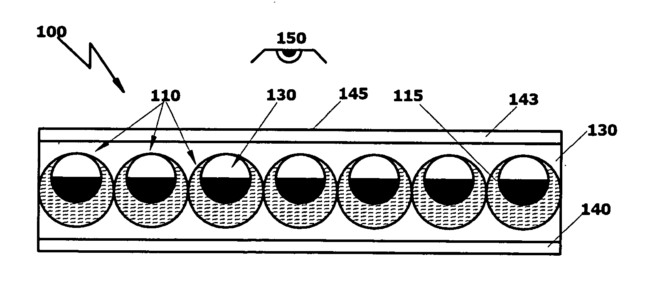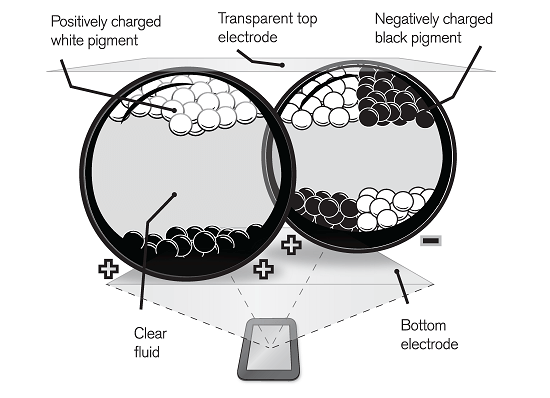
Electronic paper was first developed at the Research Center of Xerox in Palo Alto Nick Sheridana in the 70-ies of the last century. The first electronic paper, called Gyricon, consisted of polyethylene spheres between 20 and 100 microns in diameter. Each sphere were negatively charged black and positively charged white halves. All the spheres were placed in a transparent silicone sheet, which was filled with oil, so that the sphere rotated freely. The polarity of the applied voltage for each electrode pair determines which side will turn the sphere, giving, thus, the white or black point on the display.

In the 1990s, Joseph Jacobson invented another type of electronic paper and founded the Corporation E Ink which, together with Philips introduced this technology to the market. How does the modern E-Ink display — this is in the news today!

The active layer E-Ink display contains tiny transparent capsules with black and white particles (pigments). Black and white particles respond differently to the appearance of electric potential: positively charged white particles are attracted to the negatively charged electrode, and negatively charged black particles to contact with a positive charge. Thus microcapsules with pigment are very small — their diameter comparable with the diameter of a human hair. Neutral white and black particles inside the microcapsules in an arbitrary position. But when an area of the screen is given a positive electric charge, all the microcapsules in this area, the white particles move in the frontal part. A black stretch electric field on the back side of the microcapsules, thereby hiding from the eyes of the user. As a result, the display appears white spot — point pixel white. If you reverse the polarity of the applied electric potential, the black pigment particles will be on the front side of the capsule, and the white on the back. And at the same location shown as a black spot.

In E-Ink displays use an active matrix, similar to those installed in the LCD and OLED displays. This allows you to create electronic ink screen large and complex images.
In addition to the monochrome E-Ink displays there is also a multi-color electronic paper. It consists of a thin colored optical filter added to the monochrome display. Many points are divided into triads, consisting of three colors: cyan, Magenta and yellow. Unlike OLED and LCD displays which use red, green and blue colors and add them in E-Ink colors are formed by subtracting, as in the printing industry.

The advantage of E-Ink is the battery life, which compares favorably with devices with OLED and LCD displays. The fact that the display on the basis of the electronic paper consumes energy only when changing the displayed information, while the LCD display consumes power constantly. However, E-Ink displays have a very large update time compared to LCD displays. It is not possible to display complex interactive interface elements. Another disadvantage is the susceptibility of some E-Ink screens mechanical damage.
How does it work? | E-Ink-display
Hi-News.ru